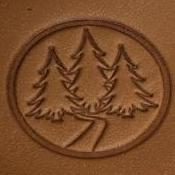-
Content Count
322 -
Joined
-
Last visited
About Double Daddy
-
Rank
Member
- Birthday 09/09/1976
Profile Information
-
Gender
Male
-
Location
N.E. Georgia
-
Interests
American political and social history, homesteading skills, technical crafts and trades, family genealogy.
LW Info
-
Leatherwork Specialty
Gunleather & accessories
-
Interested in learning about
Holster/Sheath related leatherwork
-
How did you find leatherworker.net?
Google search
Recent Profile Visitors
8,853 profile views
-
Double Daddy started following Bad bottle of dye?? Is this possible?, Wayne Jueschke Leather Tools For Sale, Any tricks for the Teflon glue pot and and 7 others
-

Wayne Jueschke Leather Tools For Sale
Double Daddy replied to bruce johnson's topic in Hand Tools-Leatherworking Tools
Whistle - Mr. Bruce was kind enough to share some of his knowledge in a thread a couple months back...lots of helpful info therein!: -
What Dwight said. I hoard pickle/jelly/olive jars and use them for things like glue and custom dye mixes (full strength and diluted). As for the Teflon pot, I haven't read near enough positives to persuade me to purchase one for use with the adhesive I use (Weldwood Red Can Original). Harbor Freight is also pretty hard to beat (at least I've found to be the case) when it comes to availability & price of those acid brushes...and the wooden handled "chip" brushes. Some stores also carry bulk boxes for even better per-unit pricing. I'm sure you could look within these forums and find HF is many a leatherworker's friend and go-to for various/sundry supply.
-

Resole cowboy boots
Double Daddy replied to PurpleBronc's topic in Shoes, Boots, Sandals and Moccassins
You keep posting (as your time allows)...and we'll keep reading!!! Most appreciated! -

Old round punches - yard sale finds - need some TLC
Double Daddy replied to Sprocket's topic in Sharpen it!
This is great wisdom, Mr. Bruce...thanks for sharing! I've been wondering about the best way to sharpen these kind of "handled" punches. My round punches are usually chucked into a drill press and get strips of wet/dry sand paper and/or emory cloth (working thru the grits as you suggested) to keep them fine tuned...but...the slack area on the belt sander would be great for what you are describing. Again...appreciate it! -
I went the same way Dwight did when it comes to custom stamps...brass being the preferred material because I tried HDPE/delrin and other plastics years ago and they didn't give the crisp results I was looking for, long term. I've always gotten great service from https://leatherstampmaker.com/ ...great folks who communicate well, ship quickly and offer lots of different options. We've ordered makers' marks of different sizes from them as well as a set of custom coaster embossing & cutting dies for production work. These will will emboss two different borders (camouflage or rope) and/or click out a simple coaster blank...the borders are spaced far enough in to allow for a stitch line to a backer material (cork, milled oil-tan, etc)...room in the center for monogramming. Peruse their website, give them a call/email...LSM will be glad to help you.
-
 Double Daddy changed their profile photo
Double Daddy changed their profile photo
-

Price Comparison: Fiebing's Neatsfoot Oil
Double Daddy replied to BigDogPaul1962's topic in Suppliers
Here's the direct Amazon link to the Farnam NFO (not a compound): https://www.amazon.com/stores/page/9DE069A2-2F42-4600-9929-AF4F5CD62B8C/search?ref_=ast_bln&terms=neatsfoot oil -

Price Comparison: Fiebing's Neatsfoot Oil
Double Daddy replied to BigDogPaul1962's topic in Suppliers
Appreciate the OP's extensive research and price comparisons...most helpful! I'm still working thru my current jug of local Tractor Supply-acquired Fiebing's 100% NFO...this post prompted me to do some shopping/price comparison of my own...came across this on one of BigDogPaul's online sources (Amazon): Might give the smaller jug a try next to see how it works out... -

kinda of an opinion thing but asking anyway
Double Daddy replied to ToddW's topic in Leatherwork Conversation
I've made a holster or three for Glocks (and other polymer frame handguns) that were not black...but in similar fashion to what Dwight pointed out above, most of mine have been dyed black leather with either matching or contrasting white thread. That said, I don't reckon there are any set rules about colors, holsters, etc. I did have that one feller who wanted a holster for his (gulp!) Hi-Point 9mm...it too was black and LH, t'boot! By my estimation...with time and materials, the holster was worth at least twice the retail cost of his weapon of choice. He could/would not be swayed towards an Uncle Mike's Walmart Special and didn't seem to mind my price (too much anyways) and has since came back several times for belts and guitar straps. What's that saying about some folks and their money? For a very decent visual side-by-side comparison of black vs. "not black" leather on a Glock handgun, check out this thread started by another leatherworker in the forums: -

Need Recommendations for Manual Clicker Press
Double Daddy replied to Stratton's topic in Leather Machinery
I considered one of the Vevor clicker presses - I had been using a modified 1-ton arbor press for clicking (mounted to the bench betwixt a widened plywood base using metal plates to "spread" the pressure load on the cutting pad over said base)...but it wasn't getting it done anymore. My hesitation over the Vevor was pretty much as you stated: uneven pressure/results front to back when clicking out items. I just endured the 1-ton for a bit longer, saved up my cereal box tops and bought a 4-ton press...no regrets. -

Need Recommendations for Manual Clicker Press
Double Daddy replied to Stratton's topic in Leather Machinery
If budget isn't an issue, BuckleGuy just came out with a new, floor mounted 12-ton manual press ($3300 plus freight)...they also have 4-ton bench mounted models for less https://www.buckleguy.com/clicker-press/ I bought my 4-ton elsewhere (same item and basic price as BG because they were out of stock at the time)...it's a handy thing to have for appropriate sized items that need cutting out (about 8.75"x11.75" work area)...also does well for stamp embossing or pushing smaller cutting dies thru leather as needed. I had no need (or room) for one of the larger floor mount models at this time. -
I use sheep sheering (I buy it in bulk quantity just for this purpose and for dying large pieces when I don't have the capacity to dip them)...only apply pure neatsfoot oil (not that compound stuff) to the hair side like Dwight said above, never the fleshy/split side...that side is WAY too thirsty for oil.
-

Can I dye brown nylon thread black?
Double Daddy replied to DeWayne Hayes's topic in Leatherwork Conversation
Sharp looking holster, both in design and color choices (dye & thread). I can absolutely see it only getting better looking as it "ages in"...such is the beauty of leather. Thanks for sharing! -
I use Denatured Alcohol for when I need to reduce my dyes...and you ain't kiddin' either about making sure the lid is screwed on tight before mixing. I keep clear graduated measuring cups on hand just for this (one could probably get them on line but I have a bunch left over from my days of doing tub/tile refinishing)...pour what's required of each component into clean pickle/olive/mason jars, seal it up tight, swirl it around first...then go to shaking. I label and keep the reduced mixtures on hand either for dipping or for wide-area dye work via pieces of shearing or airbrush.
-
Doc - See the last post in this thread - To the OP - you can use the heat emitting lamps, as Doc pointed out...they work great (I built a drying/"hot" box in the attached thread). A person could make their cabinet's workings as simple or complex as their mechanical aptitude allows. It's the temperature that you are after. Good luck!



